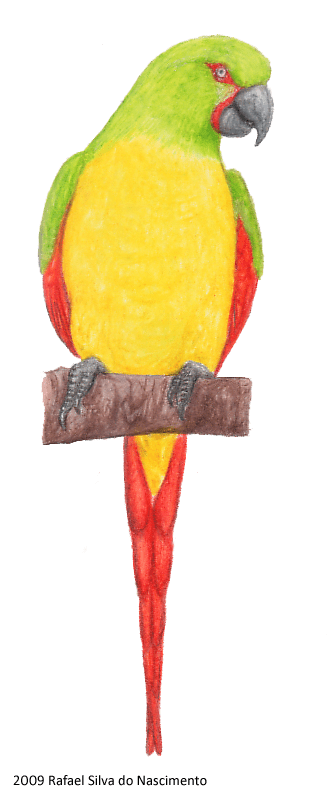Class Aves Scientific name Ara atwoodi | Phylum Chordata Order Psittaciformes Subfamily Psittacinae Rank Species | |
 | ||
Similar Lesser Antillean macaw, Red‑headed macaw, Jamaican red macaw, Saint Croix macaw, Martinique macaw | ||
The Dominican green-and-yellow macaw, Atwood's macaw, or Dominican macaw (Ara atwoodi) is an extinct species of macaw that may have lived on the island of Dominica. It is only known through the writings of zoologist Thomas Atwood in 1791.
Atwood wrote the following in his book The History of the Island of Dominica:
The macaw is of the parrot kind, but larger than the common parrot, and makes a more disagreeable, harsh noise. They are in great plenty, as are also parrots in this island; have both of them a delightful green and yellow plumage, with a scarlet-colored fleshy substance from the ears to the root of the bill, of which color is likewise the chief feathers of their wings and tails. They breed on the tops of the highest trees, where they feed on the berries in great numbers together; and are easily discovered by their loud chattering noise, which at a distance resembles human voices. The macaws cannot be taught to articulate words; but the parrots of this country may, by taking pains with them when caught young. The flesh of both is eat, but being very very fat, it wastes in roasting, and eats dry and insipid; for which reason, they are chiefly used to make soup of, which is accounted very nutritive.
No archeological remains are known of this bird, and it is thus widely considered an extinct hypothetically existent parrot. Atwood described a bird which was commonly captured for food and pets.
Austin Hobart Clark, scientifically describing the parrot, initially included these macaws in Ara guadeloupensis. On discovering Atwood's writings, however, Clark listed them separately, considering them distinct
The Dominican macaw probably became extinct in the late 18th or early 19th century.
